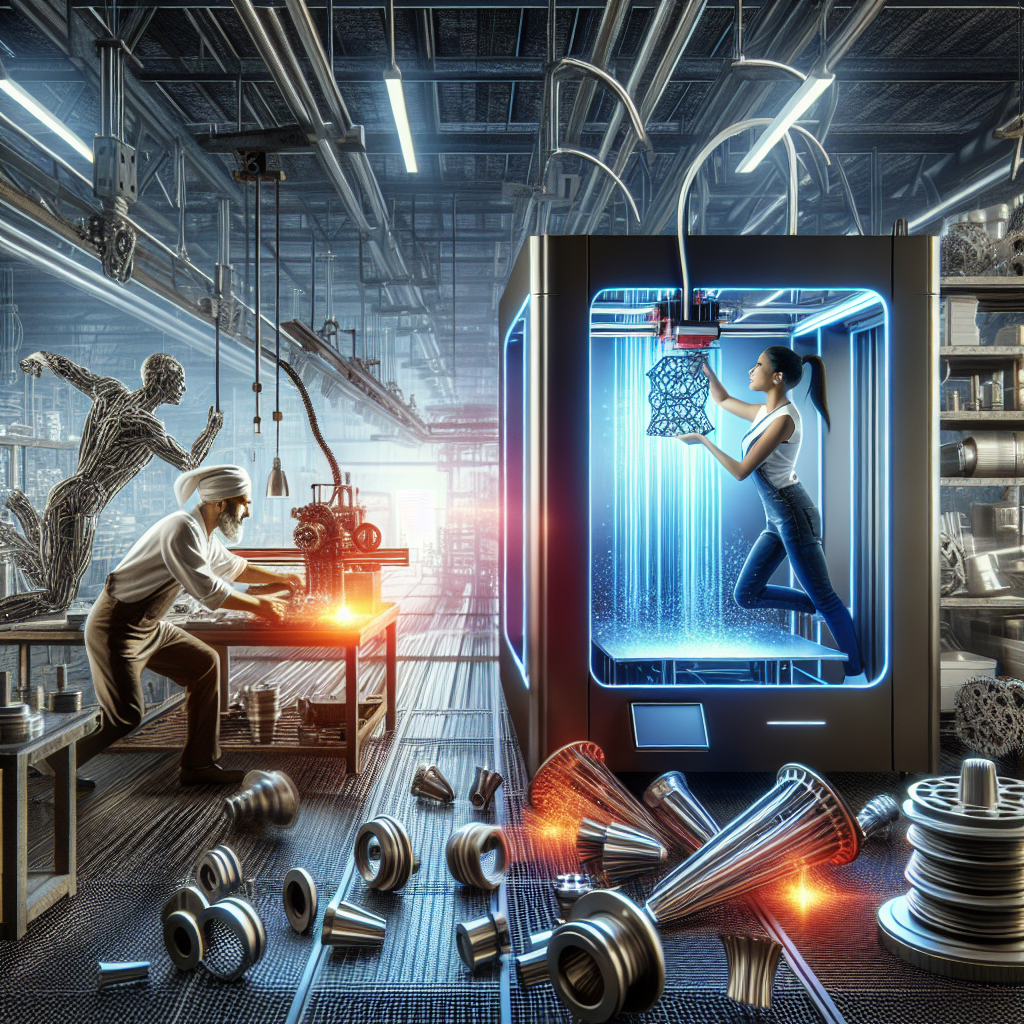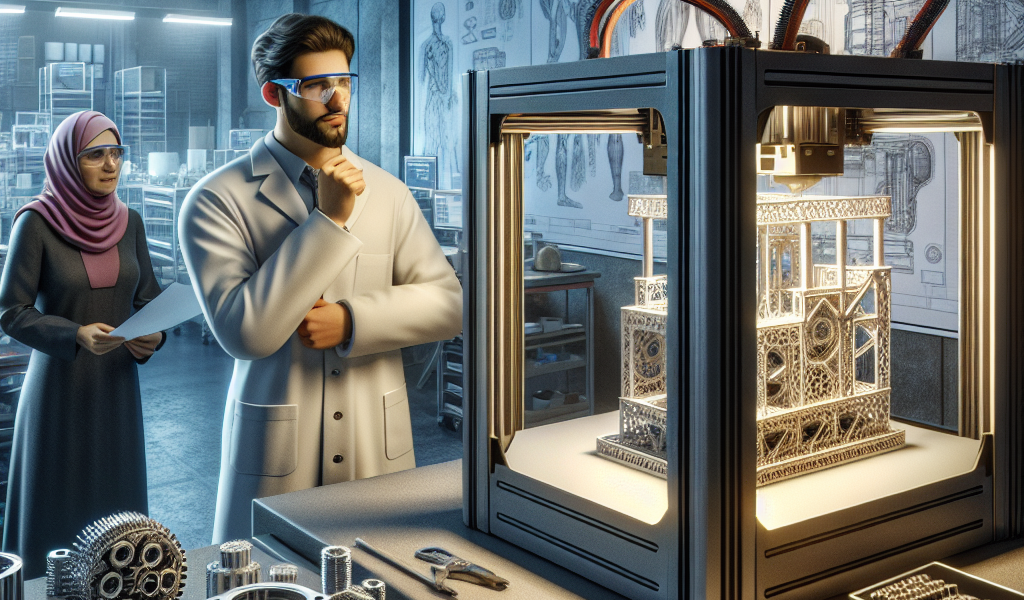-
Table of Contents
“Revolutionizing Production: 3D Printing Pioneers the Future of Manufacturing”
Introduction

3D printing, also known as additive manufacturing, is revolutionizing the manufacturing industry by enabling the creation of complex, customized, lightweight, and strong structures with reduced material waste compared to traditional manufacturing methods. This technology allows for the direct construction of objects from digital data, offering unprecedented flexibility in design and production. It supports a range of materials, including plastics, metals, and composites, facilitating its adoption across various sectors such as aerospace, automotive, healthcare, and consumer goods. The ability to rapidly prototype designs not only accelerates the development process but also significantly reduces the time and cost associated with bringing new products to market. As 3D printing technology continues to evolve, it is set to transform traditional manufacturing paradigms, promoting greater innovation and efficiency in production processes.
The Impact of 3D Printing on Supply Chain Efficiency
Title: How 3D Printing is Changing Manufacturing
In the realm of manufacturing, 3D printing is no longer just a fascinating technological experiment; it has evolved into a powerhouse that is reshaping how products are designed, produced, and delivered. This transformation is particularly evident in the enhancement of supply chain efficiency, where 3D printing, also known as additive manufacturing, is playing a pivotal role.
Traditionally, manufacturing supply chains have been hampered by the need for large inventories, extensive physical facilities, and complex logistics to manage the flow of goods from factories to end users. However, with the advent of 3D printing, these chains are becoming more streamlined and responsive. One of the most significant impacts of this technology is its ability to reduce the lead time in production processes. By enabling on-demand production, 3D printing eliminates the need for holding vast amounts of inventory, thus significantly reducing storage costs and minimizing waste from unsold products.
Moreover, 3D printing fosters a more localized production approach. Instead of relying on a centralized manufacturing facility, companies can now deploy smaller, more efficient production units closer to the end consumer. This shift not only reduces the transportation distances and costs but also diminishes the carbon footprint associated with logistics. Furthermore, it enhances the ability of companies to customize products to specific regional markets quickly and efficiently, meeting consumer demands in a timely fashion.
Another transformative aspect of 3D printing in supply chains is its impact on product design and innovation. The flexibility of 3D printers allows for more complex designs without additional cost. Designers can experiment with shapes and structures that would have been either impossible or too expensive to achieve with traditional manufacturing methods. This capability accelerates the prototyping process, enabling faster iteration and refinement of products. Consequently, companies can bring new products to market more quickly, staying ahead in competitive industries.
Additionally, 3D printing is instrumental in risk management within the supply chain. The traditional model often involves long lead times and high costs associated with tooling and setting up production lines, which can be risky if consumer demand changes unexpectedly. With 3D printing, companies can adapt more swiftly to changes in the market without significant financial losses, as adjustments to designs or production quantities can be made virtually overnight without the need for costly retooling.
The integration of 3D printing into manufacturing also opens up opportunities for more sustainable practices. By reducing material waste through precise additive processes, where material is added layer by layer instead of being cut away, companies can achieve a more environmentally friendly production. This method not only conserves raw materials but also reduces the energy consumption typically associated with mass production techniques.
As we look to the future, the continued integration of 3D printing into supply chain strategies promises even greater efficiency and responsiveness. With advancements in materials science and the ongoing development of more sophisticated printing technologies, the potential for further enhancing supply chain dynamics is vast. This evolution will undoubtedly continue to fuel innovation, pushing the boundaries of what is possible in manufacturing and beyond.
In conclusion, 3D printing is not just revolutionizing the manufacturing process itself but is also dramatically transforming supply chain management. Its ability to enhance efficiency, reduce costs, and increase product customization is setting a new standard in the manufacturing sector, making it an indispensable tool in the modern industrial landscape.
Innovations in Material Science Driven by 3D Printing Technologies
How 3D Printing is Changing Manufacturing
In the realm of manufacturing, 3D printing is not just an emerging technology; it’s a revolutionary force reshaping how products are conceived, designed, and produced. This transformation is particularly evident in the innovations spurred by advancements in material science, a field that has been dynamically influenced by the capabilities of 3D printing technologies.
Traditionally, manufacturing has been constrained by the limits of subtractive processes, where material is removed to create a final product. However, 3D printing, or additive manufacturing, flips this concept on its head by building objects layer by layer, which significantly reduces waste and allows for more complex designs. This shift not only impacts the efficiency and cost-effectiveness of production but also opens up new possibilities in the use of materials.
Material scientists are at the forefront of this revolution, engineering novel materials specifically tailored for 3D printing applications. These materials range from advanced polymers and metals to composites and even biocompatible substances that can be used in medical implants. Each of these materials brings unique properties that can be leveraged to enhance product performance, durability, and sustainability.
Moreover, the integration of 3D printing has catalyzed the development of smart materials. These substances can respond to environmental stimuli such as temperature, pressure, or moisture, which can be particularly useful in sectors like aerospace and automotive industries. For instance, materials that can change their shape or properties in response to external conditions can lead to the development of components that improve safety or efficiency.
The flexibility of 3D printing in material usage also encourages customization. In the medical field, for example, prosthetics and implants can be tailored to the specific anatomical requirements of individual patients, improving comfort and functionality. This level of customization was previously unattainable with traditional manufacturing methods and represents a significant step forward in patient care.
Furthermore, the environmental impact of manufacturing is profoundly affected by the adoption of 3D printing technologies. The precision of additive manufacturing means that material waste is minimized. Additionally, the ability to produce parts on-demand reduces the need for large inventories, cutting down on the energy and resources used in storage and transportation. This shift not only supports more sustainable manufacturing practices but also aligns with global efforts to reduce carbon footprints.
As we look to the future, the potential for further innovations in material science driven by 3D printing seems boundless. Researchers are exploring the use of recycled materials for 3D printing, which could further decrease the environmental impact of manufacturing. There’s also exciting progress in the development of conductive materials for electronics and energy devices, potentially paving the way for more integrated and efficient products.
In conclusion, 3D printing is not merely altering the landscape of manufacturing; it’s setting the stage for a more innovative, efficient, and sustainable future. As material science continues to evolve in response to this technology, the possibilities for what can be created are expanding exponentially, promising a new era of manufacturing that is as responsible as it is revolutionary.
Case Studies: How Top Manufacturers Are Integrating 3D Printing into Production Processes
How 3D Printing is Changing Manufacturing
In the bustling world of manufacturing, 3D printing is no longer just a fascinating experiment but a robust tool that is reshaping how products are designed, produced, and distributed. Leading manufacturers across various industries are not just adopting this technology; they are pioneering innovative ways to integrate it into their production processes, signaling a significant shift in the manufacturing landscape.
Take, for example, the aerospace industry, where precision and efficiency are paramount. Aerospace giants like Boeing have embraced 3D printing to produce complex aircraft parts with a level of precision that traditional methods might not achieve. This not only reduces the weight of the aircraft, leading to improved fuel efficiency but also cuts down on the number of components needed in assembly. By integrating 3D printing, Boeing has reported significant reductions in production times and costs, demonstrating a clear case of how additive manufacturing is making waves in high-stakes sectors.
Similarly, the automotive industry is driving forward with this technology. Ford, among other car manufacturers, has been using 3D printing to create prototypes for a variety of car parts. This process allows them to test and refine designs much more quickly than before. The ability to rapidly prototype with 3D printing means that design ideas can be tested and tweaked in real time, speeding up the development process and bringing new vehicles to market faster than ever.
Moreover, the medical field has perhaps shown some of the most heartening applications of 3D printing. Companies like Stryker have revolutionized the production of medical implants and devices. With 3D printing, implants can be customized to fit the unique anatomy of individual patients, which improves the comfort and effectiveness of medical treatments. This customization is critical in fields like orthopedics and dentistry, where a millimeter can be the difference between success and failure.
Transitioning to the consumer goods sector, Adidas has made headlines with its innovative use of 3D printing in creating high-performance athletic footwear. The company’s Futurecraft 4D shoes feature midsoles crafted through digital light synthesis, a form of 3D printing that uses light and oxygen to produce products from a pool of resin. This method allows Adidas to fine-tune midsoles to specific patterns of movement and cushioning, enhancing athletic performance and comfort.
Each of these examples underscores a broader trend: 3D printing is not just about creating objects; it’s about rethinking the entire production process. From reducing material waste and lowering carbon footprints to enabling mass customization and reducing lead times, the benefits are compelling. As more companies experiment with integrating 3D printing into their production lines, the potential for innovation expands exponentially.
Indeed, as we look to the future, the trajectory of 3D printing suggests a continuing evolution. With advancements in materials science, digital design tools, and printing technology, the question for manufacturers is no longer if they will adopt 3D printing, but how deeply and quickly they can integrate it to stay competitive in a rapidly changing market. This ongoing transformation in manufacturing paradigms is not just enhancing how products are made but also redefining what is possible in the industrial world.
Conclusion
3D printing is revolutionizing the manufacturing industry by enabling more versatile, cost-effective, and rapid production processes. It allows for complex designs that are difficult or impossible to achieve with traditional methods, reduces waste through additive manufacturing, and accelerates product development with rapid prototyping. Additionally, 3D printing supports customization and on-demand production, which can lead to more efficient inventory management and reduced logistics costs. As technology advances and becomes more accessible, 3D printing is likely to further disrupt traditional manufacturing paradigms, fostering innovation and potentially reshaping global manufacturing networks.





